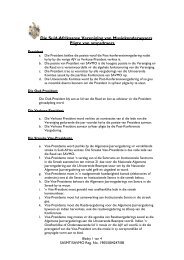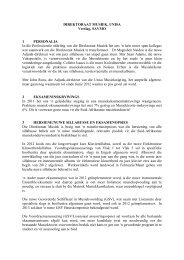2006 Edition 2 (Issue 144) - Sasmt-savmo.org.za
2006 Edition 2 (Issue 144) - Sasmt-savmo.org.za
2006 Edition 2 (Issue 144) - Sasmt-savmo.org.za
Create successful ePaper yourself
Turn your PDF publications into a flip-book with our unique Google optimized e-Paper software.
we can learn from these highly successful music educators.<br />
And thus for our edification Faan Malan was asked a<br />
battery of questions.<br />
Did you think long and hard before starting KAM? Was<br />
any research (like feasibility studies) done? Did you<br />
speak to many other people, or did you quickly do an<br />
MBA? Business plan?<br />
We were forced to make a quick decision. We were all employed<br />
in Taung, when the political uprising made it impossible<br />
to do our work. Kimberley was simply the nearest<br />
big centre and we did some planning and market research.<br />
In March 1994 we called all the Kimberley music teachers<br />
to a meeting in the Teachers’ Centre and told them what<br />
we had in mind and we asked their blessing. The rest is<br />
history. No one did an MBA — maybe later.<br />
Did KAM have trouble with finding and retaining learners?<br />
Did you advertise? How?<br />
We had the blessing of the music teachers in town. They<br />
gave us all the support we needed. The people of Kimberley<br />
also accepted us with open arms. All we had to do was<br />
to make sure we offer quality tuition. Word-of-mouth was<br />
(and still is) the main method of advertising.<br />
Which relationships did you build with other stakeholders<br />
such as schools and local government? Did you have<br />
suitable contacts, or a network of supporters in important<br />
places? Can you provide advice to others who will<br />
attempt something similar?<br />
Government was in turmoil at this time (1994). We had to<br />
rely on basics such as good service, honesty and co-operation<br />
with schools. The network of supporters and contacts<br />
followed.<br />
Did you find that the institution had to adapt to a<br />
changing environment? What are some of the external<br />
pressures that you have (had) to contend with?<br />
Today, almost 13 years later, the Kimberley Academy of<br />
Music is a completely different institution. From a private<br />
music school with only a small number of staff and students,<br />
we are now the Music Faculty of the National Institute<br />
for Higher Education in the Northern Cape, with 700<br />
students and 14 staff members.<br />
There are numerous external pressures. Classical music<br />
has to compete with sport and all sorts of instant entertainment.<br />
Due to our efforts, several schools in Kimberley<br />
now have their own music programmes, orchestras,<br />
choirs, shows, etc. We have to compete for a slice of the<br />
‘time cake’. Then there is money. Tuition fees had to be<br />
high to make it worthwhile for our teachers.<br />
How did you (and the rest of your staff) deal with the<br />
uncertainties that accompany the start of a new venture?<br />
What were some of the risks that you had to take?<br />
Initially we were only three teachers. It is important not<br />
to spend too much initially on setting up. We hired classrooms<br />
at a junior school in the afternoons for a few months<br />
before investing in property for our venture. We initially<br />
invested much time and enthusiasm (rather than money)<br />
and quickly built up a clientele. The quicker our student<br />
numbers grew, the more secure we felt. We felt very confident<br />
that we could make a success of starting and running<br />
such a music school — there were no uncertainties that I<br />
can remember.<br />
Where there any unsuspected opportunities that helped<br />
KAM along the way?<br />
The establishment of the National Institute for Higher<br />
Education (NIHE) in the Northern Cape had a major influence<br />
on the development of KAM. This changed our<br />
direction and scope by introducing an exciting era of tertiary<br />
studies.<br />
Do you have strategies to find out what learners and<br />
parents think? To what extent are they partners in planning<br />
and executing activities such as rehearsals and<br />
concerts? Or are they simply executing orders?<br />
The only strategy we follow is one of personal contact. We<br />
often talk to our clients and establish what their needs are<br />
in an informal way. Very often it becomes necessary to tell<br />
them what to do.<br />
How important is it for your staff members to be good<br />
role models? What specific things do they do? Are they<br />
involved in continued professional development?<br />
Very important. We have staff concerts and play in ensembles<br />
and bands together with students. Most of the staff<br />
members are busy studying something and attend related<br />
workshops regularly. Skills development is a pre-requisite<br />
for employment at the Academy of Music.<br />
Are their certain processes in place to ensure shared<br />
ownership of the institution?<br />
The Kimberley Academy of Music is a Section 21 (nonprofit<br />
making) Company. Five of the seven board members<br />
are staff members.<br />
How do you find and keep the continued support of<br />
your community?<br />
We offer services to schools such as help and support for<br />
choirs, orchestras, school concerts and musical productions.<br />
Our staff and students perform at various community<br />
based events. We try to stay in the public eye.<br />
How did you ensure that your institution created profit?<br />
How did you establish the lesson fees?<br />
Creating a profit was never the goal of this project. Making<br />
enough money to pay salaries and necessary expenses was<br />
the aim. Income (lesson fees) was worked out by deciding<br />
how much a teacher should earn. An average is 25 hours<br />
teaching (50 X 30min lessons)<br />
Teachers were paid 90% of this income as salary and were<br />
responsible for their own tax and the other 10% was used<br />
for Academy expenses. This budget did not allow for anything<br />
but the absolute necessities – luxuries were OUT as<br />
we put the emphasis on the standard of education and our<br />
relationships with clients. This scenario is based on the<br />
Academy when it was totally private — before the merger<br />
with NIHE.<br />
Suid-Afrikaanse Musiek Onderwyser |<strong>144</strong> | November <strong>2006</strong>




